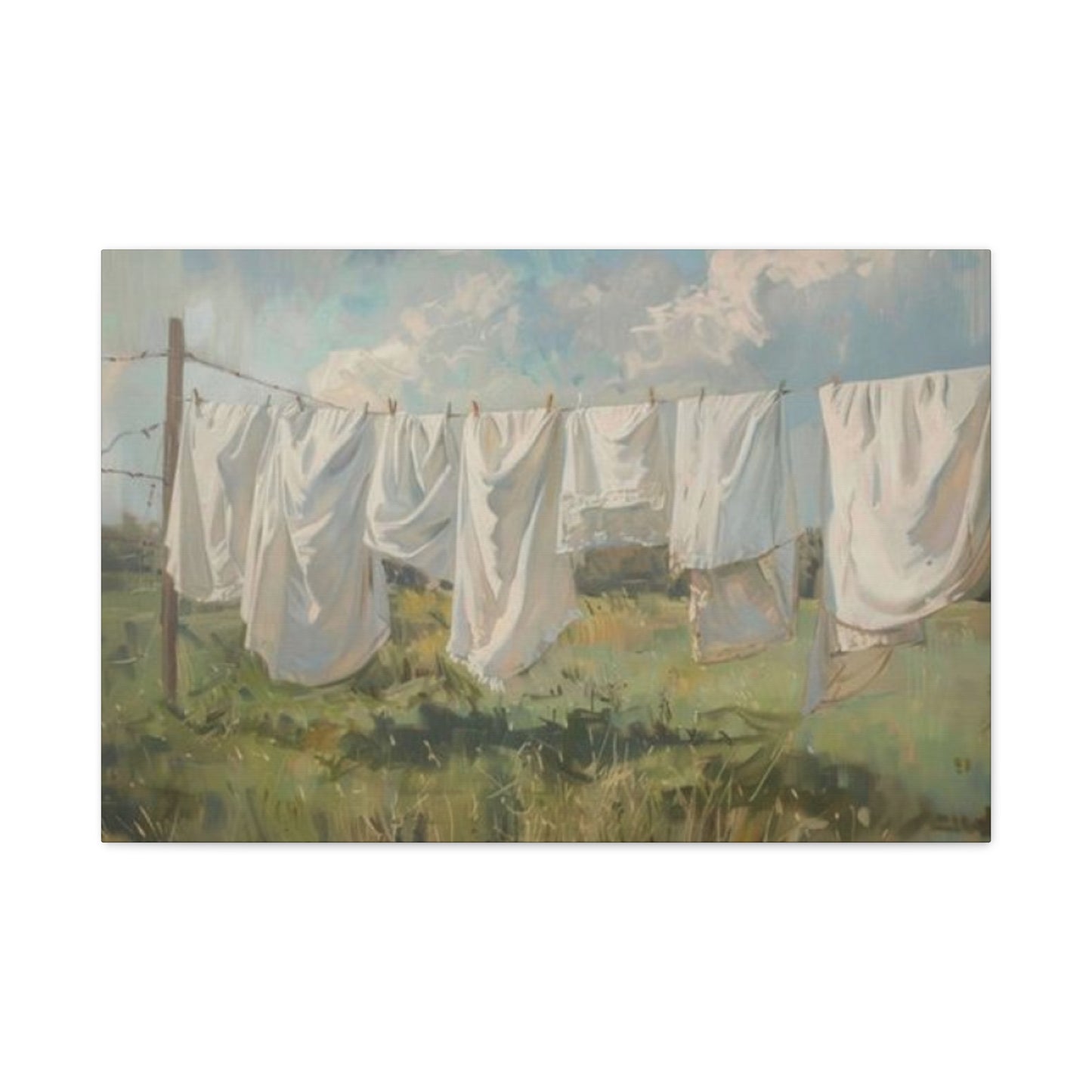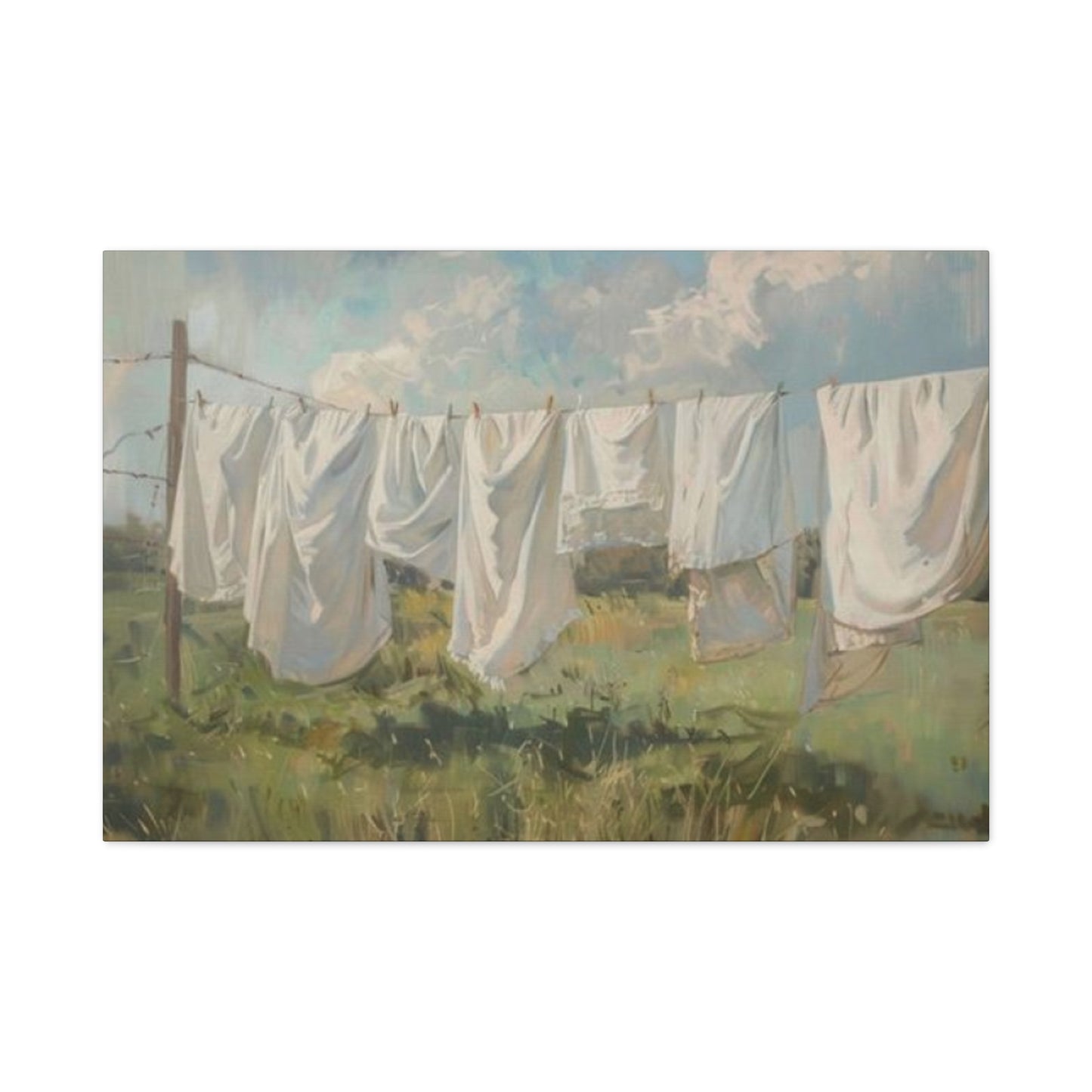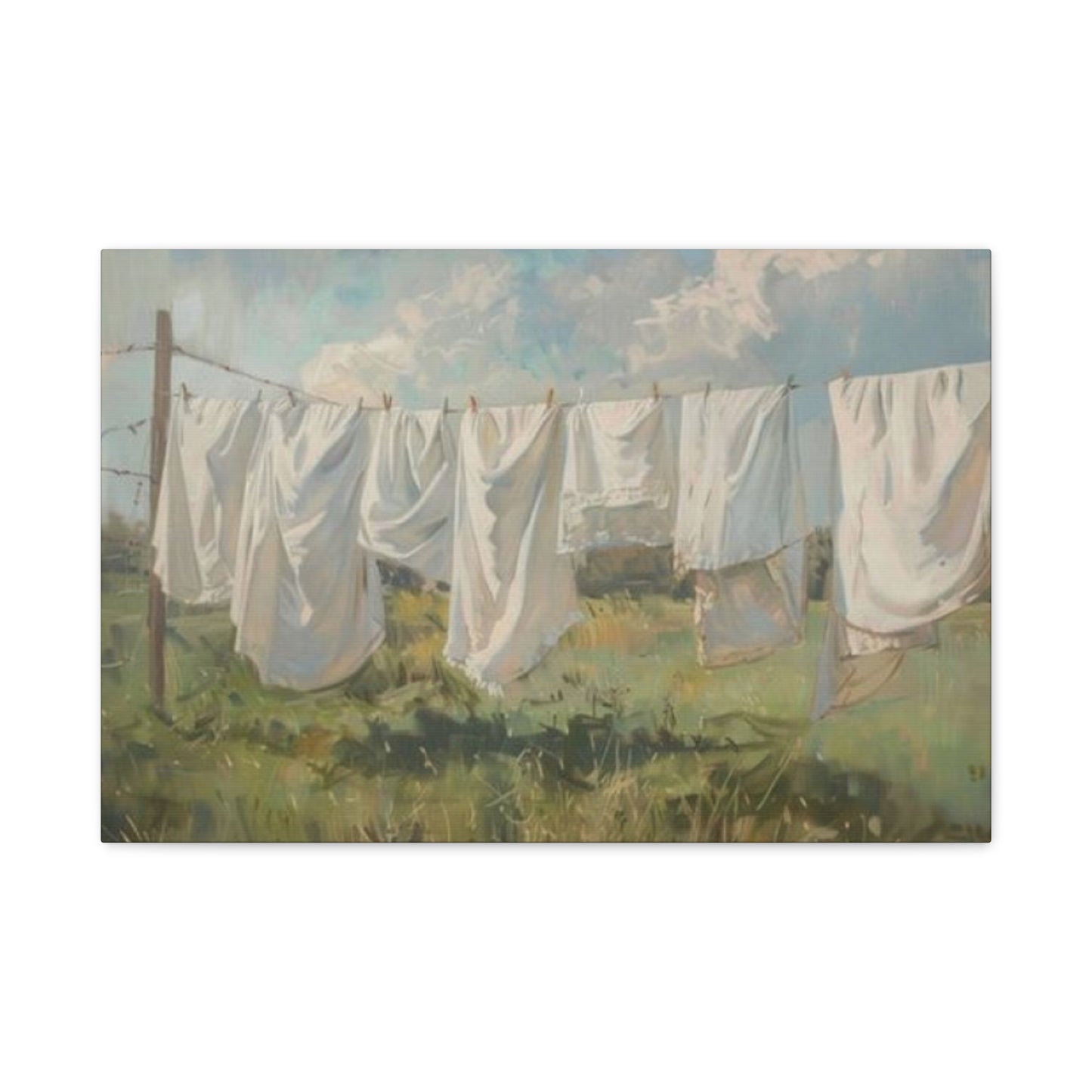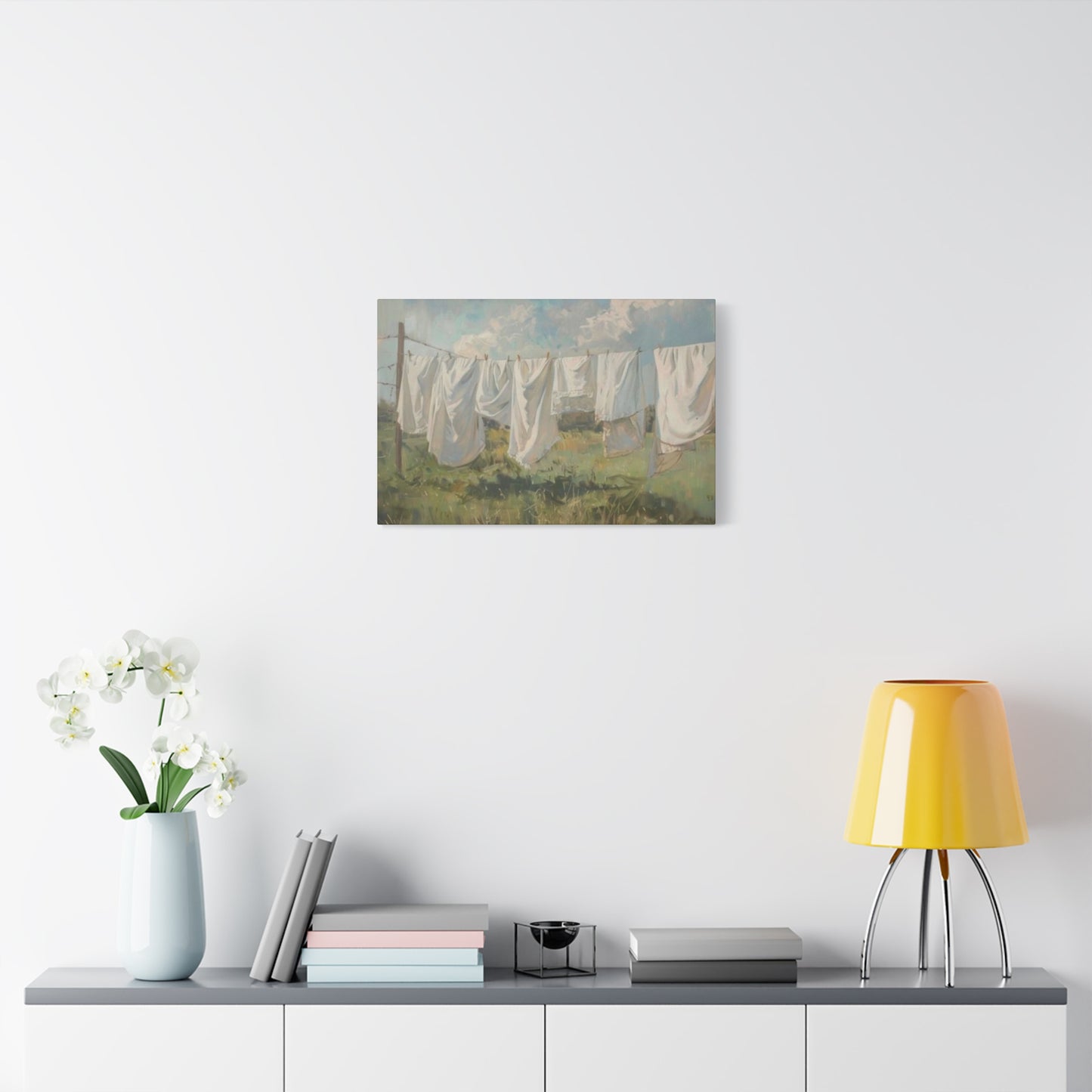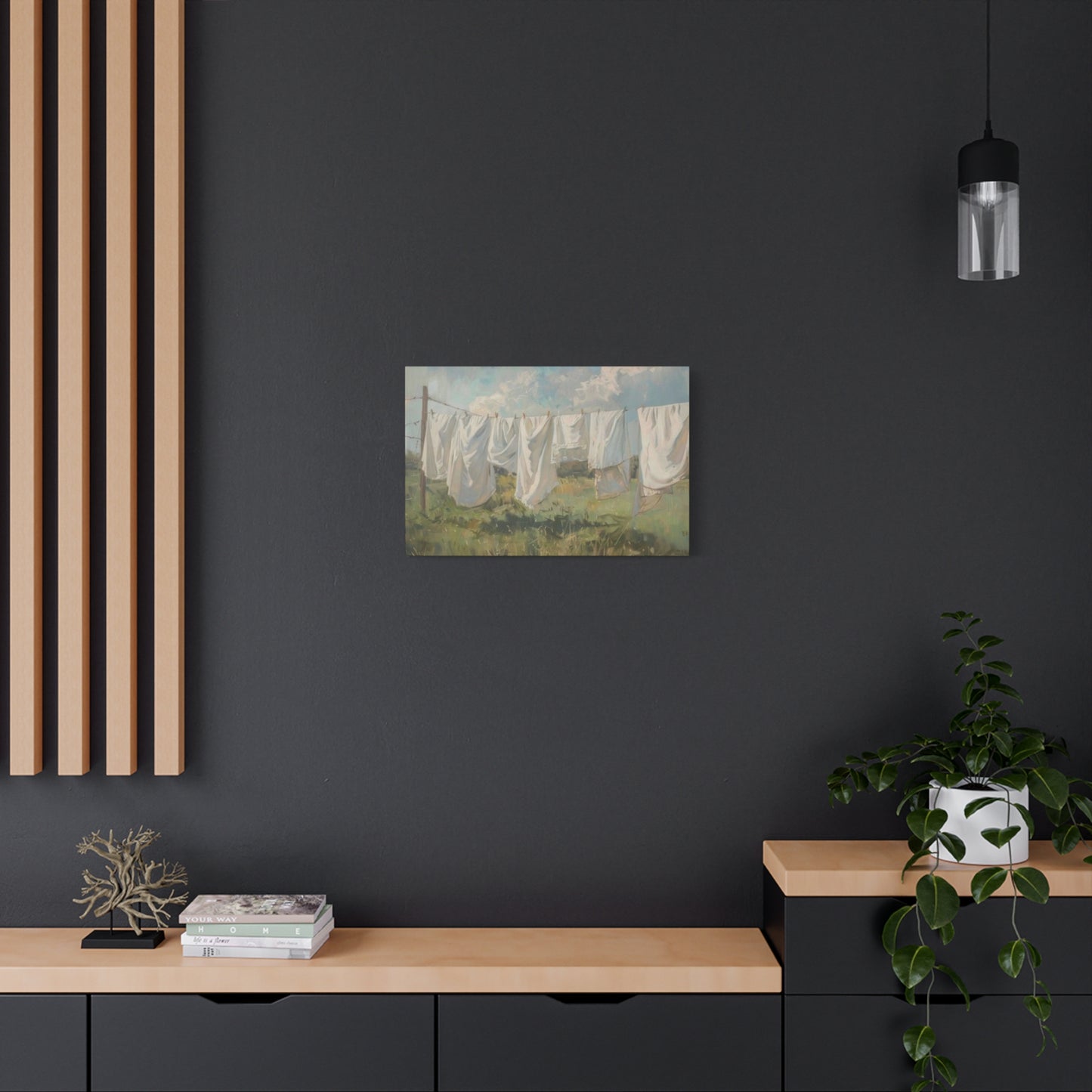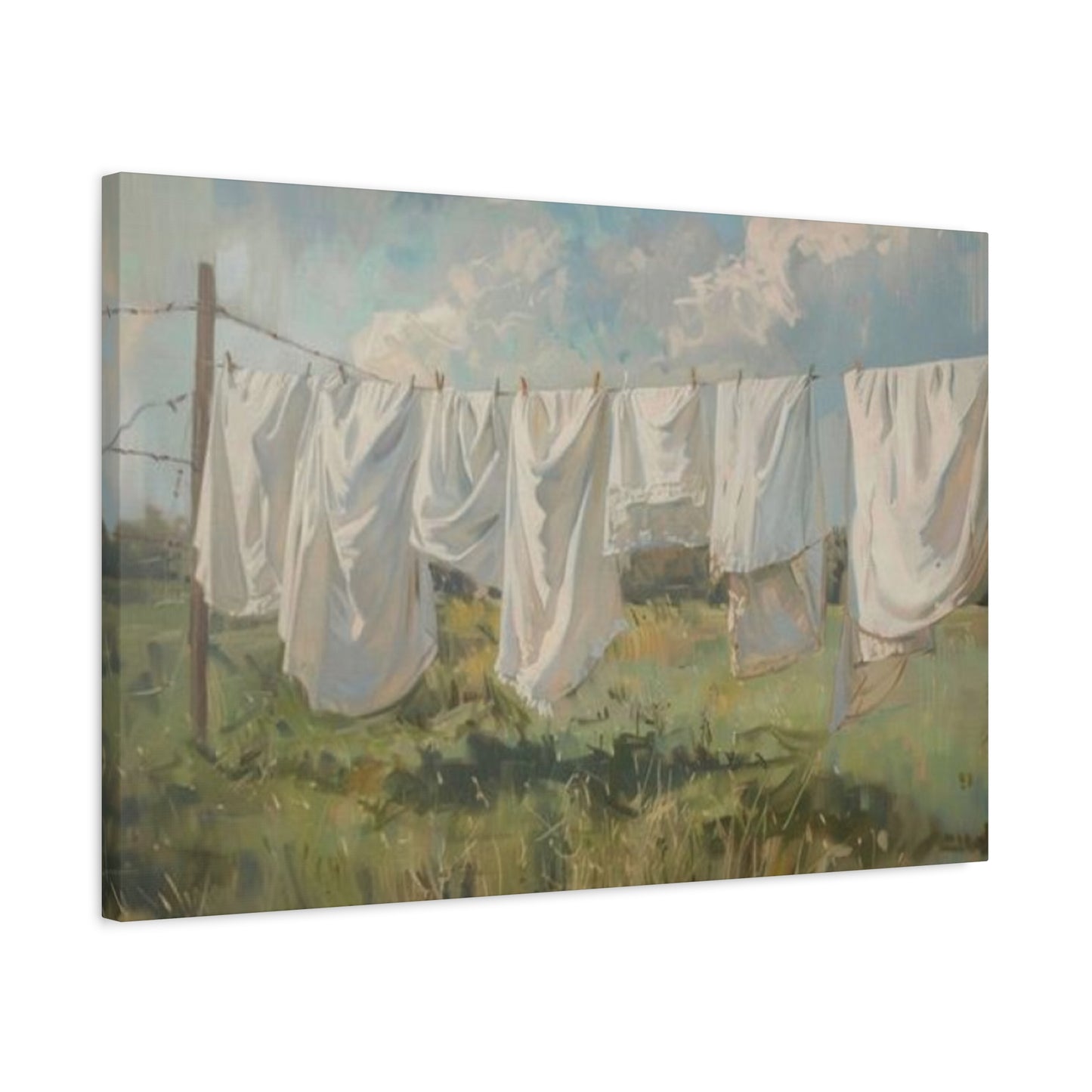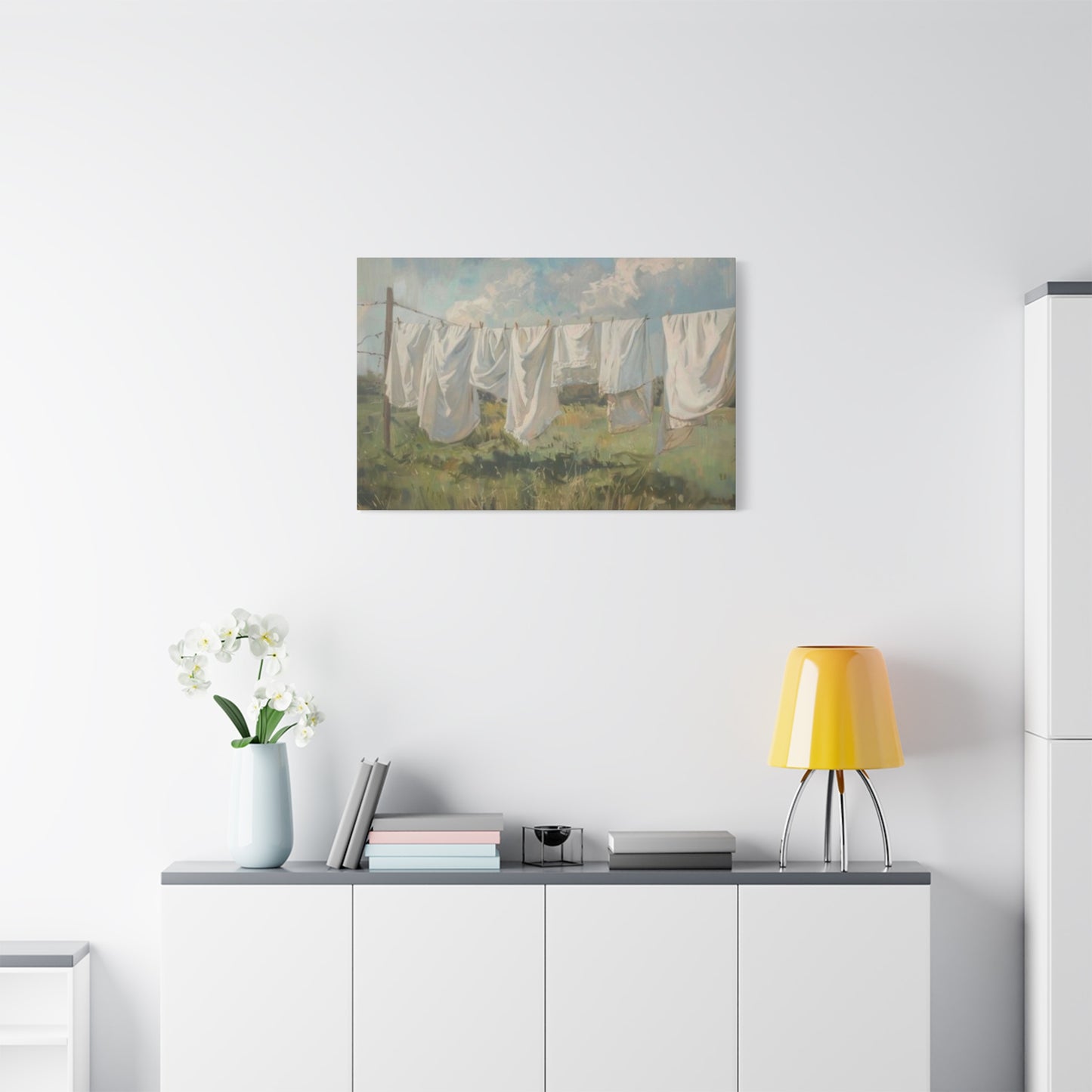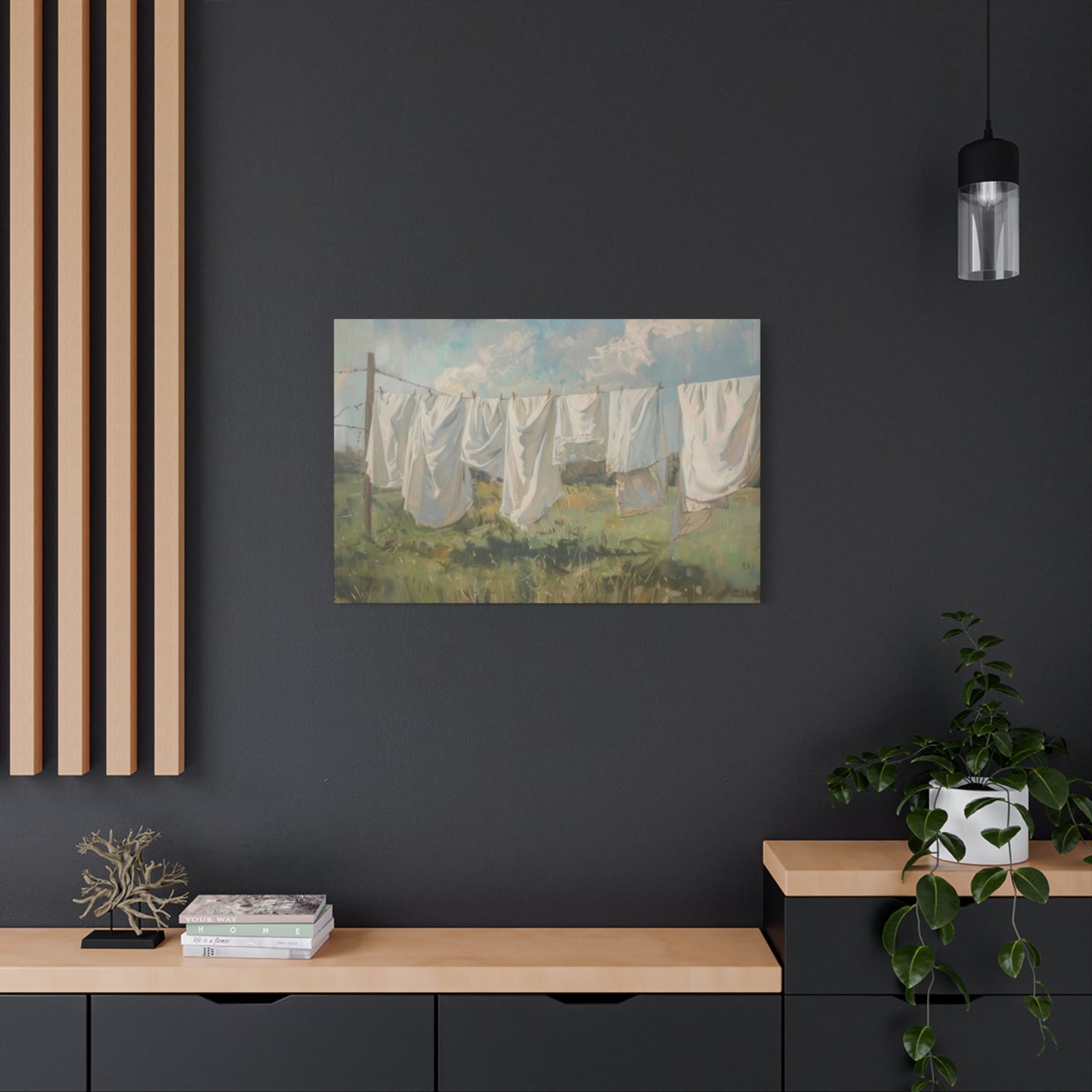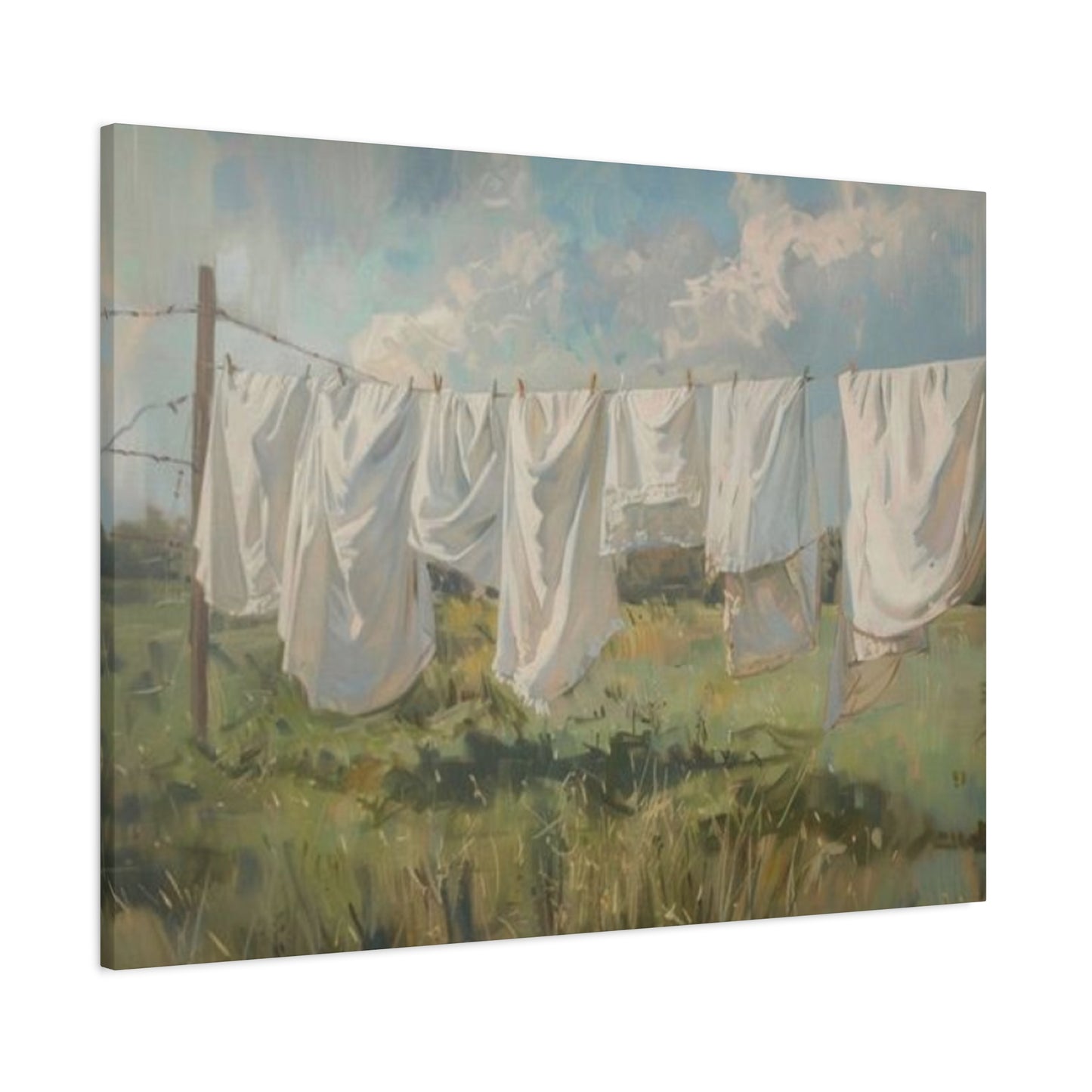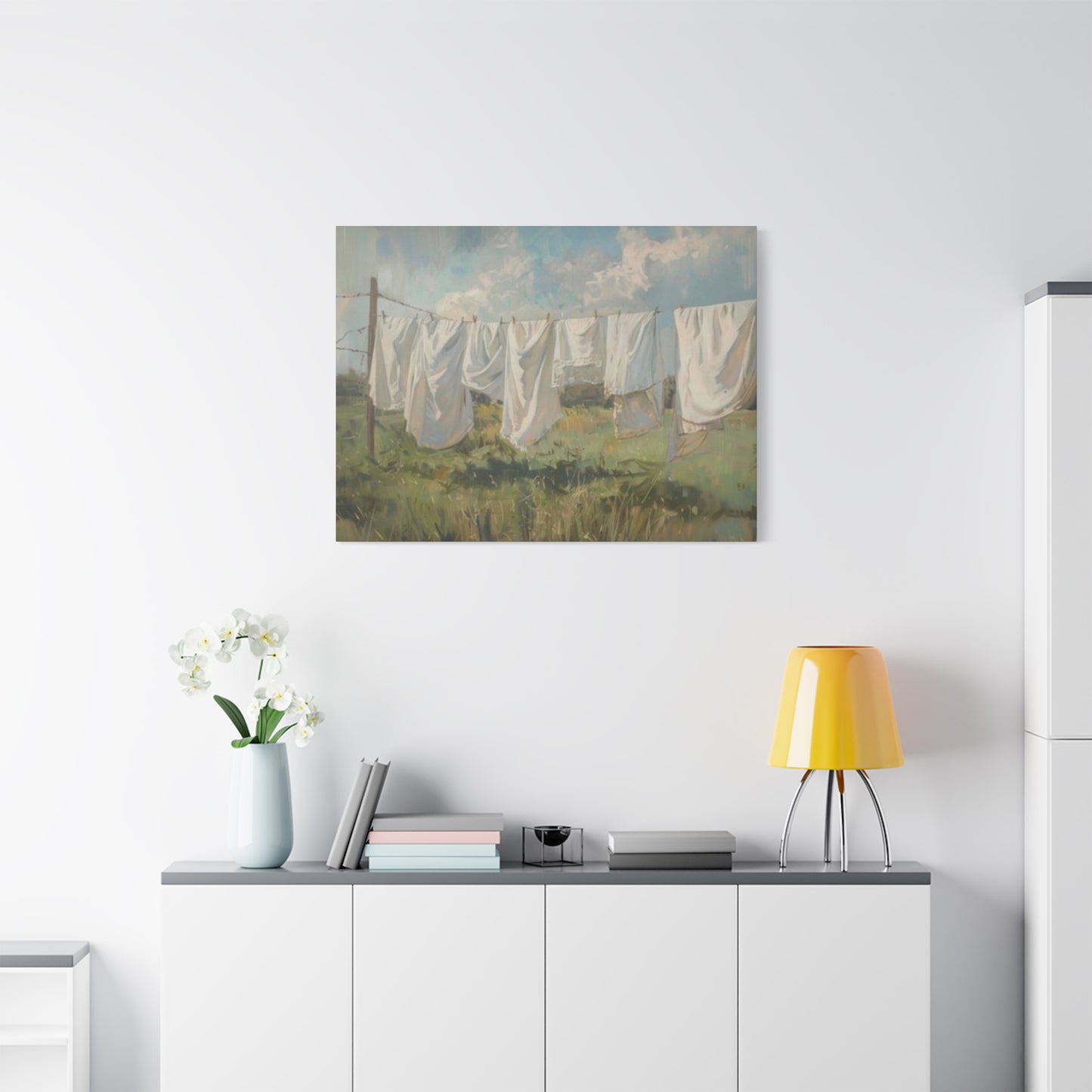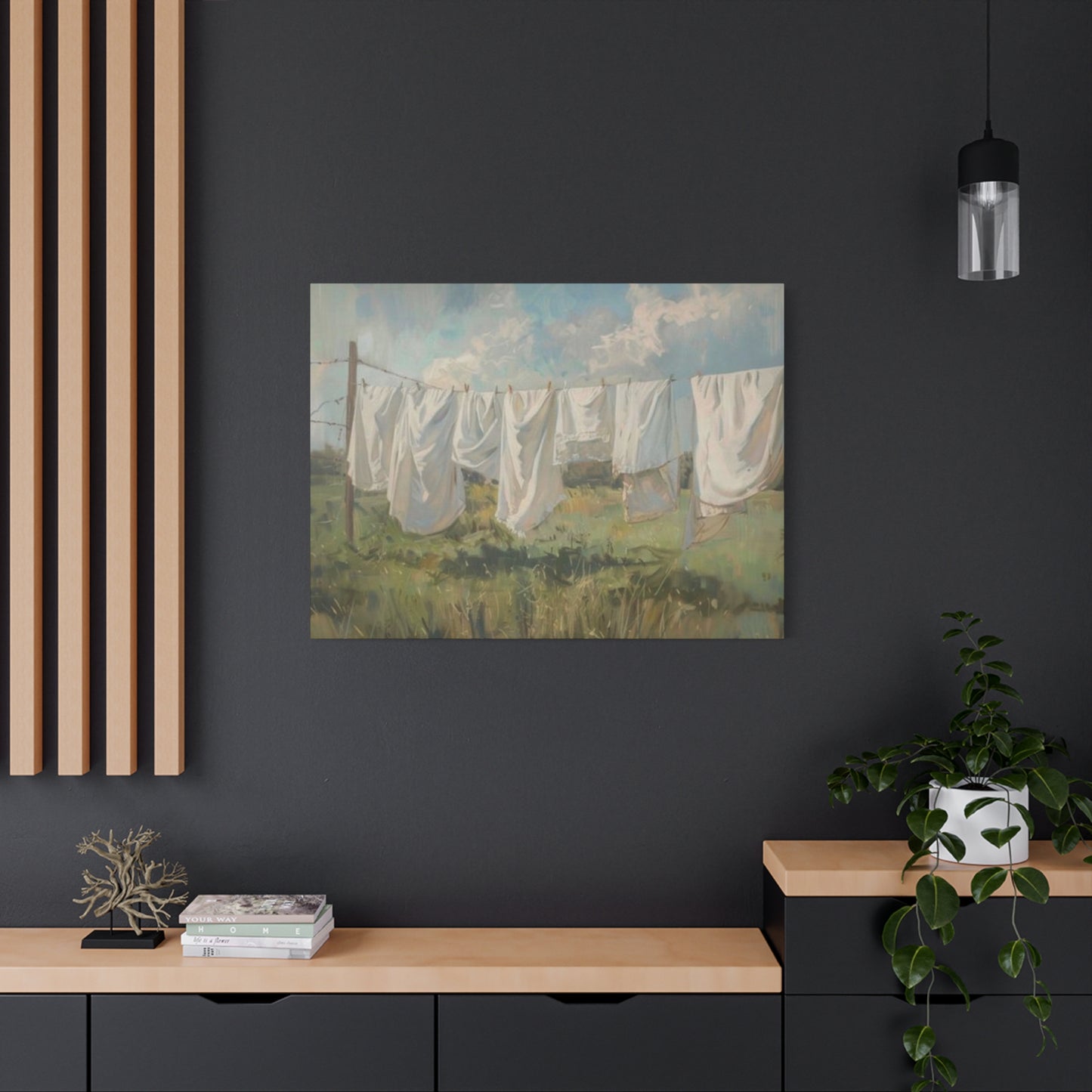Fresh Perspectives on White Clothes Drying Laundry Wall Art for Modern Living Spaces
The concept of white clothes drying laundry wall art represents a fascinating intersection between ordinary domestic life and artistic expression. This unique form of decoration has captured the imagination of interior designers and homeowners alike, transforming mundane household chores into captivating visual statements. When we look at freshly laundered white garments hanging on a line, there's an undeniable poetry in their simplicity that speaks to both nostalgia and modern minimalist aesthetics.
The appeal of this particular style lies in its ability to evoke memories while maintaining contemporary relevance. White laundry fluttering in the breeze has been a common sight throughout human history, yet when captured as wall art, it takes on new meaning. The clean lines, pure colors, and natural movement frozen in time create a sense of tranquility that modern homes often lack. This artistic interpretation of domestic life brings warmth and authenticity to living spaces that might otherwise feel sterile or impersonal.
Many homeowners are drawn to this theme because it represents comfort, cleanliness, and the simple pleasures of home life. The visual impact of white fabrics against various backgrounds creates striking contrasts that work well in multiple interior design schemes. Whether displayed in a laundry room, kitchen, bedroom, or living area, these pieces add character without overwhelming the existing decor. The versatility of this artwork makes it suitable for farmhouse, coastal, Scandinavian, and even industrial design styles.
The emotional resonance of laundry-themed artwork cannot be understated. For many people, the sight of clean clothes drying recalls childhood memories of helping parents with household tasks or the comforting smell of sun-dried linens. This nostalgia factor makes such artwork particularly appealing to those seeking to create homes that feel lived-in and loved rather than merely decorated. The authenticity of the subject matter provides a refreshing alternative to abstract or overly stylized art pieces.
From a practical standpoint, white clothes drying laundry wall art serves multiple purposes in home decoration. It can lighten dark spaces, create visual interest on blank walls, and tie together various elements of a room's color scheme. The predominantly white tones in these pieces make them excellent choices for rooms where you want to maintain an airy, open feeling. They work particularly well in spaces dedicated to household tasks, adding beauty to areas that are often overlooked in terms of decoration.
The growing popularity of this art style reflects broader trends in interior design toward authenticity and meaningful decoration. People are increasingly rejecting generic artwork in favor of pieces that tell stories or reflect personal values. Laundry-themed art celebrates the everyday work that goes into maintaining a home, elevating these tasks from mere chores to artistic subjects worthy of display. This shift represents a more holistic approach to home decoration that values function alongside aesthetics.
Exploring Different Artistic Styles and Mediums
White clothes drying laundry wall art comes in numerous artistic styles, each offering unique visual appeal and emotional impact. Photography-based pieces capture real moments of laundry hanging outdoors, preserving the natural light, shadows, and textures that make these scenes so compelling. These photographs can range from highly detailed close-ups showing individual fabric textures to wide-angle shots that include surrounding landscapes or architectural elements. The photographic approach provides authenticity and realism that resonates with viewers seeking genuine representations of domestic life.
Painted interpretations offer different possibilities for artistic expression. Watercolor renditions of laundry scenes tend to be soft and dreamy, with colors bleeding into one another to create atmospheric effects. These pieces often emphasize the movement and flow of fabrics in the breeze, capturing a sense of motion that static photography cannot always convey. Oil paintings, by contrast, can provide rich textures and bold contrasts, making the white fabrics appear almost luminous against darker backgrounds. Acrylic paintings strike a balance between these approaches, offering versatility in both technique and final appearance.
Digital art and mixed media pieces represent more contemporary approaches to this traditional subject matter. Artists working in these mediums can manipulate images in ways that emphasize certain aspects of the scene while minimizing others. They might enhance colors, adjust contrasts, or add artistic filters that transform ordinary laundry photos into striking visual statements. Mixed media pieces might combine photography with painted or drawn elements, creating layered compositions that blend realism with artistic interpretation. These approaches appeal to those seeking artwork that feels both familiar and distinctly modern.
Illustrations and line drawings provide simplified, stylized versions of laundry scenes. These can range from highly detailed pen-and-ink drawings to minimalist line art that suggests rather than depicts the subject. The advantage of illustrated pieces lies in their flexibility and adaptability to various interior design schemes. A simple line drawing of clothes on a line can complement modern minimalist spaces, while more detailed illustrations might suit traditional or eclectic interiors. These pieces often have a handcrafted quality that adds warmth and personality to a room.
Canvas prints remain one of the most popular mediums for this type of wall art. The texture of canvas adds depth and interest to the image, while the format allows for easy hanging and positioning on walls. Gallery-wrapped canvases, where the image extends around the sides of the frame, create a finished look that doesn't require additional framing. This makes them particularly convenient for homeowners who want ready-to-hang artwork. Canvas prints can reproduce photographs, paintings, or digital art with excellent color fidelity and durability.
Creating Visual Impact Through Composition and Placement
The effectiveness of white clothes drying laundry wall art depends significantly on how pieces are composed and where they're placed within a room. Compositional elements within the artwork itself play crucial roles in determining visual impact. Images that follow the rule of thirds, with key elements positioned at intersection points rather than centered, tend to be more visually engaging. The direction of clotheslines within the image can lead the viewer's eye across the piece, creating dynamic movement even in a static image.
Perspective greatly influences how viewers experience laundry-themed artwork. Close-up shots that show fabric details and textures create intimate, almost tactile viewing experiences. These pieces work well in smaller spaces or as part of gallery wall arrangements where viewers can appreciate fine details. Wide-angle compositions that include context like landscapes, buildings, or skies create more expansive feelings and work better as statement pieces in larger rooms. The choice between these approaches should reflect both the available space and the desired emotional impact.
Color balance within predominantly white-themed artwork requires careful consideration. While the laundry itself may be white or light-colored, the surrounding elements provide opportunities for color introduction. Blue skies, green foliage, weathered wood, or colorful buildings in the background can add visual interest without overwhelming the main subject. These accent colors should harmonize with the room's existing color palette, creating cohesion rather than conflict. Even in nearly monochromatic pieces, subtle variations in white tones and shadows provide depth and interest.
The placement of laundry artwork within a room dramatically affects its impact and the overall room atmosphere. In dedicated laundry rooms, such pieces serve both decorative and inspirational purposes, making necessary tasks feel more pleasant. Positioned above a washer and dryer or on a blank wall near folding areas, this artwork reinforces the room's purpose while adding visual appeal. The key is choosing pieces that don't add clutter to typically small spaces while still making a meaningful decorative contribution.
Kitchen placement offers interesting possibilities, especially in homes where kitchen and laundry functions share space or adjoin. Laundry-themed art in kitchens reinforces themes of domestic comfort and home care that naturally suit these spaces. Placing such pieces near breakfast nooks or dining areas can create cozy, lived-in feelings that make these gathering spaces more inviting. The artwork should complement rather than compete with kitchen elements like cabinets, countertops, and appliances.
Living rooms and family rooms provide larger canvases for laundry-themed artwork, allowing for more substantial pieces or groupings. In these spaces, the artwork contributes to overall ambiance rather than serving functional room identification purposes. A large laundry scene can serve as a conversation starter and focal point, especially when it captures particularly striking light conditions or locations. The casualness of the subject matter helps living spaces feel welcoming rather than formal, encouraging relaxation and family interaction.
Bedroom placement creates intimate settings where the comforting associations of fresh laundry particularly resonate. Hanging such artwork above beds or on bedroom accent walls reinforces feelings of cleanliness, comfort, and rest. The predominantly white color schemes common in these pieces also promote the calm, serene atmosphere desired in sleeping spaces. Choosing images with softer light and gentler compositions helps maintain the restful quality bedrooms require.
Embracing Farmhouse and Rustic Aesthetics
The farmhouse interior design movement has significantly boosted interest in white clothes drying laundry wall art, as the subject matter perfectly embodies the rural, nostalgic qualities central to this style. Farmhouse design celebrates simplicity, functionality, and connections to agricultural life, making images of laundry drying outdoors natural fits. These pieces evoke times when outdoor line drying was necessity rather than choice, connecting modern homes to traditional practices that defined rural domestic life for generations.
Rustic wooden elements frequently appear in both the artwork itself and its presentation. Images showing laundry hung on weathered wooden posts, vintage wooden clothespins, or rustic backdrops like old barns or farmhouses amplify the country aesthetic. When these images are then mounted on reclaimed wood or framed in distressed wooden frames, the rustic effect compounds, creating cohesive pieces that feel authentically vintage. The combination of subject and presentation communicates values of simplicity and connection to the past that farmhouse enthusiasts cherish.
Neutral color palettes dominate farmhouse design, making white laundry imagery particularly suitable. The predominance of whites, creams, and soft grays in these artworks coordinates effortlessly with typical farmhouse color schemes. When accent colors appear, they often include the soft blues of sky, gentle greens of foliage, or muted earth tones that complement rather than overwhelm. This color harmony allows the artwork to integrate seamlessly into farmhouse-styled spaces without requiring color adjustments elsewhere in the room.
Vintage and antique elements enhance the farmhouse appeal of laundry-themed art. Images that include old-fashioned elements like vintage wash basins, traditional wicker laundry baskets, or antique irons add layers of historical interest. These details transport viewers to earlier eras when laundry was more labor-intensive, celebrating the domestic work that sustained families and communities. For those who appreciate the romance of simpler times, these vintage touches make the artwork particularly meaningful.
Shiplap walls and other characteristic farmhouse architectural elements provide ideal backgrounds for displaying laundry art. The horizontal lines of shiplap create visual rhythm that complements the linear nature of clotheslines, while the neutral white or gray paint typical of this treatment doesn't compete with the artwork for attention. Similarly, exposed beams, brick walls, and other rustic architectural features enhance rather than distract from laundry-themed pieces, creating harmonious overall compositions.
Natural materials and textures throughout farmhouse spaces reinforce connections to the outdoors and simpler lifestyles. Laundry art showing clothes drying in natural settings with visible breezes, sunshine, and outdoor elements strengthens these connections. When displayed alongside other natural materials like woven baskets, wooden furniture, stone elements, or plants, the artwork becomes part of a larger narrative about living in harmony with nature and traditional ways.
Incorporating Coastal and Beach House Elements
Coastal design styles find natural affinity with white clothes drying laundry wall art, as the imagery evokes seaside living and beach house aesthetics. Images of white linens fluttering in ocean breezes, perhaps with glimpses of blue water or sandy beaches in backgrounds, perfectly capture the relaxed, breezy feeling coastal designs aim to achieve. The connection between fresh laundry and the clean, refreshing qualities of seaside environments makes this pairing particularly effective.
The color palette common in coastal design aligns beautifully with laundry-themed artwork. White fabrics against blue skies mirror the ocean-and-sky combinations central to beach house color schemes. When these pieces include subtle aqua, turquoise, or navy accents, they coordinate with typical coastal interior colors without demanding attention. The light, airy quality of white laundry art helps create the open, breezy atmosphere that defines successful coastal design.
Natural light plays crucial roles in both coastal living spaces and laundry-themed artwork. Images capturing bright, clear light flooding through white fabrics or creating dramatic shadows emphasize the sun's presence in ways that resonate with beach life. Displaying these pieces in rooms with abundant natural light allows them to change throughout the day as real light conditions vary, creating dynamic viewing experiences that keep spaces feeling alive and connected to the outdoors.
Nautical elements can enhance coastal laundry artwork without overwhelming its simplicity. Rope used as hanging mechanisms or frame embellishments subtly reinforces maritime themes. Images showing laundry drying near boats, docks, or coastal cottages strengthen connections to seaside settings. However, restraint proves important to avoid creating overly themed spaces that feel contrived. The goal is suggesting coastal connections rather than creating literal nautical displays.
Weathered and whitewashed finishes characteristic of coastal furniture and decor complement laundry-themed artwork beautifully. When pieces are mounted on whitewashed wood or framed in weathered finishes that suggest exposure to salt air and sun, they feel authentically coastal. These treatments create visual continuity between the artwork and surrounding furnishings, making spaces feel curated and intentional rather than randomly assembled.
Casual, comfortable lifestyles associated with beach living align well with the unpretentious subject matter of laundry art. Unlike formal or elaborate artwork that demands specific viewing conditions or careful placement, laundry-themed pieces feel approachable and relaxed. They communicate that the home is a place for living rather than a showroom, which perfectly suits the easygoing atmosphere coastal designs strive to create. This casualness invites family and guests to relax and feel at home.
Scandinavian Minimalism Meets Domestic Simplicity
Scandinavian design principles of minimalism, functionality, and celebration of simplicity make white clothes drying laundry wall art surprisingly fitting despite cultural differences. The clean lines, uncluttered compositions, and emphasis on white and neutral tones in these pieces align perfectly with Nordic design aesthetics. While the subject matter might seem too specific or decorative for purist minimalism, thoughtfully chosen pieces can enhance rather than compromise Scandinavian-inspired spaces.
The functionality inherent in laundry imagery resonates with Scandinavian values around purposeful design. Unlike purely decorative artwork with no connection to daily life, laundry-themed pieces celebrate practical domestic activities. This connection to real life and useful work aligns with Nordic appreciation for objects and images that serve meaningful purposes. The artwork doesn't just beautify; it acknowledges and honors the labor that maintains comfortable homes.
Monochromatic and near-monochromatic color schemes dominate both Scandinavian interiors and white laundry artwork. The emphasis on white, cream, gray, and black creates visual calm and helps small spaces feel larger and more open. Laundry art featuring primarily white fabrics against neutral backgrounds reinforces these color choices without introducing jarring elements. Even when subtle color appears, it's typically in the soft blues, greens, or earth tones that complement Scandinavian palettes.
Natural light, highly valued in Nordic countries with long, dark winters, features prominently in effective laundry-themed artwork. Images capturing how light interacts with white fabrics showcase beauty in everyday moments, reflecting Scandinavian appreciation for finding joy in simple pleasures. Displaying such artwork in well-lit spaces or near windows maximizes its impact and reinforces the importance of light in creating welcoming interiors.
Hygge, the Danish concept of cozy contentment, connects surprisingly well to laundry imagery. The comfort and security suggested by clean, fresh linens evoke feelings central to hygge philosophy. Images of laundry drying outdoors might initially seem to contradict hygge's indoor, winter-focused origins, but they actually extend the concept by showing the preparations that create cozy homes. Fresh sheets and soft fabrics are essential elements of the comfortable environments hygge celebrates.
Photography Techniques That Capture Laundry Beauty
Professional photography of white clothes drying for wall art requires specific techniques to effectively capture the subject's beauty while creating images suitable for home display. Lighting stands as the most critical factor, with natural outdoor light typically producing the most appealing results. Golden hour lighting shortly after sunrise or before sunset creates warm glows that make white fabrics appear luminous. The long shadows and soft light during these times add drama and depth that midday light cannot match.
Backlighting creates particularly striking effects with white laundry. When photographed with light sources behind the fabrics, they become semi-translucent, glowing with ethereal quality. This technique emphasizes the delicate nature of the textiles while creating strong silhouettes of clothespins, lines, and supporting structures. However, photographers must carefully manage exposure to prevent white fabrics from becoming completely blown out, losing all detail and texture.
Composition decisions dramatically affect the final image's suitability as wall art. Filling the frame entirely with hanging laundry creates abstract, pattern-based images that work well in modern spaces. Including more context like landscapes, buildings, or sky creates narrative images that tell stories about where and how the laundry is drying. Both approaches have merit; the choice depends on the intended display location and desired emotional impact.
Depth of field manipulation allows photographers to emphasize certain elements while softening others. Shallow depth of field with wide apertures can isolate single garments or small sections of clotheslines, creating dreamy images where backgrounds blur beautifully. Deeper depth of field captures entire scenes in sharp focus, allowing viewers to appreciate every detail from foreground laundry to distant backgrounds. The technique should serve the artistic vision for each specific piece.
Movement and wind add life to laundry photography. Capturing fabrics mid-flutter as breezes catch them creates dynamic images that convey freshness and outdoor conditions. Fast shutter speeds freeze motion crisply, while slower speeds can introduce artistic blur that suggests movement. Both approaches work, though the frozen motion technique typically produces more commercially successful images for wall art purposes.
Color management proves especially important with predominantly white subjects. While the laundry itself may be white or light-colored, surrounding elements provide color that must be captured accurately. Blue skies should appear natural rather than oversaturated, greens should feel realistic, and any weathered wood or architectural elements should display their true character. Post-processing color adjustments must enhance rather than distort the scene's natural palette.
Artistic Painting Techniques for Laundry Subjects
Painted interpretations of white clothes drying offer artistic freedom that photography cannot match, allowing artists to emphasize certain elements while simplifying or eliminating others. Watercolor techniques particularly suit this subject matter, as the flowing, transparent nature of the medium echoes the light, airy quality of fabrics moving in breezes. Wet-on-wet watercolor methods create soft edges and color bleeding that suggest movement and atmosphere rather than depicting them literally.
Layering watercolor washes builds depth and luminosity in painted laundry scenes. Starting with very pale washes for the white fabrics and gradually adding subtle shadows and tonal variations creates forms without heavy-handedness. Each successive layer adds dimension while maintaining the light, fresh feeling essential to successful laundry imagery. The key is restraint; too many layers or too much pigment can muddy the desired clean appearance.
Oil painting techniques offer different possibilities, with impasto methods adding texture that creates almost sculptural surfaces. Thick applications of paint can suggest fabric folds and billowing forms three-dimensionally. The slow drying time of oils allows extended working periods for blending and refinement, enabling subtle transitions between light and shadow that give white fabrics convincing volume. Oil paintings also offer rich color saturation for background elements like skies or landscapes.
Acrylic painting combines some advantages of both watercolors and oils. The medium dries quickly, allowing rapid layer building without extended waiting periods. Acrylics can be thinned for transparent washes similar to watercolors or used thickly for textured applications like oils. This versatility makes acrylics popular for artists creating laundry-themed work in various styles from loose and impressionistic to tight and realistic.
Impressionistic approaches to painting laundry scenes focus on capturing overall feeling rather than precise details. Loose brushwork and simplified forms convey the essence of white fabrics drying outdoors without laboriously rendering every fold and wrinkle. These paintings often emphasize light effects and color harmonies, creating mood and atmosphere that viewers respond to emotionally rather than intellectually. The impressionistic style feels particularly appropriate for capturing ephemeral qualities like sunlight and breezes.
Palette knife painting creates distinctive textures and bold, simplified forms. Using knives rather than brushes to apply paint results in flat color areas with sharp edges between them. This technique can transform laundry scenes into almost abstract compositions of geometric shapes and color blocks. The resulting paintings feel contemporary and graphic, working well in modern interiors where softer, more traditional painting styles might seem out of place.
Creating Gallery Walls with Laundry Themes
Gallery walls featuring multiple pieces of laundry-themed artwork create impactful displays that transform blank walls into focal points. The key to successful gallery walls lies in finding balance between unity and variety. When all pieces share laundry themes, they already have conceptual unity, allowing for variation in size, orientation, color treatment, and framing without the arrangement feeling chaotic or random.
Planning layouts before hanging anything prevents costly mistakes and unnecessary wall damage. Creating paper templates matching each piece's dimensions and temporarily taping them to the wall allows experimentation with arrangements. Try various configurations until finding one that feels balanced and visually pleasing. Consider how pieces relate to one another and to the wall space itself, leaving appropriate breathing room rather than crowding elements together.
Symmetrical arrangements create formal, orderly appearances that suit traditional spaces. Matching pairs of images flanking a central larger piece, or grid arrangements with evenly spaced pieces of identical sizes, provide structure and predictability. These organized layouts work particularly well in formal living rooms, dining rooms, or bedrooms where order and calm are desired. The repetition inherent in laundry imagery reinforces the pattern-based quality of symmetrical arrangements.
Asymmetrical gallery walls feel more casual and contemporary, suiting modern and eclectic spaces. These arrangements might cluster smaller pieces around larger anchors, create organic groupings that spread across walls, or use varying frame styles and colors for added interest. The challenge lies in achieving visual balance without symmetry, ensuring one side or area doesn't feel significantly heavier than others. Stepping back frequently during the arrangement process helps assess overall balance.
Color coordination among the pieces and their frames creates cohesion. Since laundry-themed art often features white as the dominant color, frame choices significantly impact the overall color story. Matching frame colors creates unity, while intentionally varying them can add visual interest if done thoughtfully. Consider how frame colors relate to wall color and other room elements to ensure the gallery wall feels integrated into the space rather than applied to it.
Varying piece sizes adds visual interest and helps fill spaces efficiently. Combining large statement pieces with smaller supporting images creates hierarchy and prevents monotony. The largest piece often serves as the arrangement's anchor, with smaller pieces grouped around it. This size variation also allows for including detail shots and wider contextual images within the same display, providing viewers with different perspectives on the theme.
Spacing between pieces affects the gallery wall's overall impact. Tight spacing creates dense, busy appearances where individual pieces almost merge into single larger compositions. Generous spacing allows each piece more prominence and gives viewers' eyes places to rest. There's no universal correct spacing; the decision should reflect the desired effect and the specific pieces involved. Generally, spacing between two and four inches works well for most arrangements.
Incorporating non-laundry elements can enhance rather than dilute themed gallery walls. Including vintage washboards, antique clothespins, or small shelves displaying laundry-related objects creates dimensional interest and reinforces the theme beyond purely pictorial representation. These three-dimensional elements transform flat wall displays into more engaging compositions. However, restraint prevents the display from becoming cluttered or overly busy.
Seasonal Variations and Rotating Displays
Changing laundry-themed artwork seasonally keeps home decor feeling fresh and responsive to the passage of time. The outdoor nature of many laundry images makes them naturally suited to seasonal interpretation, with different light qualities, weather conditions, and surrounding vegetation indicating various times of year. Rotating pieces seasonally requires minimal effort while significantly impacting how spaces feel throughout the year.
Spring imagery typically features fresh green backgrounds, bright clear light, and perhaps flowering trees or gardens visible in backgrounds. These pieces convey renewal, freshness, and the joy of returning to outdoor activities after winter. Spring laundry art often includes brighter whites and more vibrant colors overall, reflecting the season's energetic, optimistic character. Displaying these pieces during spring months helps interiors feel aligned with outdoor conditions.
Summer artwork emphasizes bold blue skies, strong sunlight, and lush vegetation. Images captured during summer months often show the most dramatic light and shadow contrasts, with brilliant highlights on white fabrics and deep shadows beneath. The visual intensity of summer pieces creates energetic, active feelings appropriate for the season. These images work particularly well in rooms where families gather during warmer months, reinforcing vacation and leisure associations.
Autumn variations introduce warmer light qualities and changing foliage colors. Golden afternoon light gives white fabrics amber glows, while backgrounds might show orange and red leaves or harvest imagery. The softer, more nostalgic quality of autumn laundry art suits the season's reflective, transitional nature. These pieces feel cozy and comforting as days shorten and outdoor activities decrease, making them perfect for fall display.
Winter laundry imagery takes more thoughtful selection, as most people don't dry laundry outdoors during cold months. However, pieces showing laundry against snowy backgrounds or gray winter skies have distinctive beauty. The contrast between white snow and white fabrics creates almost monochromatic compositions with subtle tonal variations. Winter pieces can also show indoor drying arrangements near radiators or fireplaces, acknowledging seasonal reality while maintaining the laundry theme.
Holiday-specific variations might subtly incorporate seasonal celebration elements without becoming overtly themed. Images showing red or green accent colors in backgrounds or clips during December, or pastel-colored fabrics during spring holidays, add festive touches while remaining tasteful. The goal is suggesting seasonal celebration without creating explicitly holiday-themed displays that become dated quickly or feel forced.
Storage solutions for off-season pieces ensure they remain in good condition. Wrapped in acid-free paper and stored flat in dry locations, artwork stays protected and ready for rotation. Organized storage with clear labeling makes seasonal changes quick and simple rather than requiring extensive searching. Some homeowners photograph their various arrangements to remember which pieces they've used together successfully, streamlining future seasonal updates.
The psychological benefits of seasonal rotation extend beyond simple visual variety. Marking time through intentional changes in home decoration provides rhythm and structure to years that might otherwise blur together. The ritual of switching artwork can become a pleasant seasonal tradition, a small ceremony acknowledging transitions between different times of year. This mindful approach to home decoration promotes presence and awareness of seasonal cycles.
Maintaining and Caring for Laundry Wall Art
Proper care extends life and preserves the appearance of laundry-themed wall art. Different materials and presentation methods require specific maintenance approaches. Understanding these requirements helps homeowners protect their investment and keep artwork looking fresh for years.
Dust accumulation affects all wall art over time. Regular dusting with soft, dry cloths or feather dusters prevents buildup that can become embedded and difficult to remove. Microfiber cloths work particularly well, attracting and holding dust rather than redistributing it. Dust frames, glass, and any exposed artwork surfaces gently to avoid scratching or damaging delicate materials. Establishing regular dusting routines during normal home cleaning prevents neglect.
Glass or acrylic glazing protecting artwork requires careful cleaning to avoid streaks and scratches. Glass cleaner applied to cloths rather than directly on glazing prevents liquid from seeping under frames or damaging artwork. Wipe in straight lines rather than circles to minimize streaking. Acrylic glazing scratches more easily than glass; use only cleaners specifically formulated for acrylic and very soft cloths. Never use ammonia-based cleaners on acrylic as they can cause clouding or crazing.
Canvas prints without glass require different care approaches. Dust these gently with soft brushes or compressed air used carefully at low pressure from appropriate distances. Never use liquid cleaners directly on unprotected canvas as they can stain or damage the printed surface. If canvas becomes soiled, professional cleaning may be necessary. Preventing dust accumulation through regular light cleaning proves easier than addressing heavy soiling.
Metal prints need minimal maintenance beyond dusting and occasional wiping with damp cloths. The durable finishes on metal prints resist fading, moisture, and most damage. They can handle more aggressive cleaning than paper or canvas but still benefit from gentle treatment. Dry thoroughly after damp cleaning to prevent water spots. The low-maintenance nature of metal prints makes them practical for laundry rooms and other challenging environments.
Environmental factors significantly impact artwork longevity. Direct sunlight causes fading and deterioration in most artwork over time. Position pieces away from windows receiving direct sun, or use UV-protective glazing if sun exposure cannot be avoided. Temperature and humidity extremes also damage artwork; maintain stable conditions without dramatic fluctuations. Avoid hanging artwork in bathrooms without adequate ventilation or other high-humidity environments unless pieces have moisture-resistant construction.
Proper hanging hardware prevents damage from falls and ensures secure mounting. Use appropriate wall anchors for wall types and artwork weights. Lightweight pieces can hang from simple picture hooks, while heavier pieces need sturdy hangers attached to wall studs or substantial anchors. Check hanging hardware periodically to ensure continued security, especially in homes with vibration from nearby traffic, construction, or other sources.
Rotation and storage of seasonal pieces requires careful handling. When removing artwork from walls, avoid stacking multiple pieces directly atop one another where frames can scratch or damage each other. Wrap pieces individually in acid-free paper or bubble wrap, securing wrapping with tape that doesn't contact artwork surfaces. Store flat rather than leaning when possible to prevent warping. Climate-controlled storage areas protect artwork from temperature and humidity extremes during off-display periods.
Professional restoration services can address damage from accidents, environmental exposure, or age. Tears in canvas, fading colors, moisture damage, or broken frames might all benefit from professional attention. While restoration costs money, valuable or personally meaningful pieces justify the investment. Consult professional framers or art conservators for damage assessment and restoration recommendations. Early intervention often costs less than addressing advanced deterioration.
Insurance considerations for valuable artwork provide financial protection against loss or damage. Document pieces with photographs and purchase records, noting artist names, edition numbers, and acquisition costs. Some homeowners' insurance policies include artwork coverage up to certain values; higher-value pieces may require additional riders. Understanding insurance coverage helps homeowners make informed decisions about protecting their collections.
DIY Projects and Customization Ideas
Creating personalized laundry-themed wall art through DIY projects offers unique pieces reflecting individual style and circumstances. Photographing your own laundry drying outdoors creates artwork with personal meaning. The scene might include your actual home, garden, or outdoor space, making the piece a documentation of your life rather than generic decoration. Personal photographs gain sentimental value that purchased artwork rarely achieves.
Choosing optimal times and conditions for DIY laundry photography requires planning. Visit your intended shooting location at different times of day to observe lighting conditions. Early morning and late afternoon typically provide the most attractive light for outdoor photography. Consider how backgrounds look at various times; morning light might illuminate certain areas beautifully while leaving others in shadow. Test different weather conditions if possible, as overcast days create different moods than sunny ones.
Staging laundry for photography allows creative control over composition and aesthetic. Select white or light-colored items that photograph well. Mix different fabric types and garment styles for visual variety. Arrange pieces thoughtfully on the line, considering how they'll appear in the frame. Create intentional compositions rather than random arrangements. This staging transforms utilitarian laundry drying into artistic subjects worth photographing.
Equipment requirements for DIY laundry photography can be minimal. Modern smartphone cameras capture quality images suitable for printing, especially for smaller sizes. However, dedicated cameras with manual controls offer more creative possibilities. Wide-angle lenses capture expansive scenes including context and landscape, while telephoto lenses compress perspective and isolate specific elements. Tripods ensure sharpness in lower light conditions or when using slower shutter speeds for creative blur effects.
Editing and post-processing enhance raw images, correcting exposure issues and emphasizing desired qualities. Basic adjustments to brightness, contrast, and saturation improve most images. Cropping refines compositions, eliminating distracting elements and emphasizing important features. Color correction ensures accurate reproduction of whites and subtle tones. Many free and low-cost editing applications provide these capabilities without requiring extensive technical knowledge or expensive software.
Printing options for DIY work range from budget-friendly to premium. Online printing services offer canvas, metal, acrylic, and framed print options at competitive prices. Upload digital files, select sizes and materials, and receive finished pieces by mail. Local print shops provide similar services with the advantage of in-person consultation and often faster turnaround. For highest quality, professional photo printing services specializing in fine art reproduction ensure color accuracy and longevity.
Painting your own laundry scenes offers creative expression regardless of artistic skill level. Simple watercolor washes create impressionistic interpretations without requiring technical expertise. The forgiving nature of watercolors allows experimentation and happy accidents that often produce interesting results. Start with simple compositions and light color palettes, building confidence before attempting more complex subjects. Online tutorials provide guidance for beginners developing painting skills.
Mixed media projects combine multiple materials and techniques for unique results. Collage pieces might incorporate fabric scraps representing the laundry subject, combined with painted or drawn elements. Three-dimensional pieces might include actual clothespins or miniature clotheslines. These approaches create one-of-a-kind artworks impossible to purchase commercially. Mixed media work particularly suits those who enjoy crafting and hands-on creative processes.
Family collaboration on DIY laundry art projects creates meaningful shared experiences. Children can help photograph, paint, or assemble pieces, making the finished artwork a family creation. These collaborative pieces gain significance beyond their aesthetic qualities, representing family time and creativity. Display them proudly despite any technical imperfections; the meaning transcends professional polish.
Upcycling existing pieces into laundry-themed artwork extends creative possibilities. Plain canvas or framed prints can be modified with paint, fabric, or other materials to incorporate laundry themes. Old windows or shutters might become frames for laundry photographs or paintings. Vintage washboards can be decorated and hung as standalone pieces or incorporated into larger arrangements. These upcycling projects combine creativity with sustainability.
Shopping Considerations and Where to Find Pieces
Finding perfect laundry-themed wall art requires knowing where to look and what to consider during selection. Online marketplaces offer vast selections from independent artists and commercial producers. Sites specializing in artwork provide searchable databases where you can filter by style, size, color, and price. The convenience of online shopping allows browsing extensive options from home, though inability to see pieces in person before purchasing presents some risk.
Independent artist platforms connect buyers directly with creators, often offering original work or limited editions. These platforms support individual artists while providing unique pieces unlikely to appear in many homes. Many artists accept custom commission requests, creating personalized work to your specifications. The quality and artistic merit often exceed mass-produced alternatives, though prices may be higher for original or limited-edition work.
Local art fairs and craft shows present opportunities to see artwork in person before purchasing. Meeting artists directly provides insights into their processes and inspirations. You can assess size, color accuracy, and quality firsthand, eliminating uncertainties that accompany online shopping. Supporting local artists strengthens community art scenes while acquiring unique pieces with regional character or subject matter.
Home decor retailers offer curated selections balancing artistic quality with commercial appeal. These stores often provide multiple sizes and framing options for popular images, simplifying coordination with specific spaces. The professional curation means quality typically meets certain standards, though selections may be less adventurous than independent artist offerings. Pricing generally falls between mass-market and original art, representing reasonable value for good quality.
Antique stores and vintage markets occasionally yield laundry-themed artwork with authentic age and character. Original vintage photographs or paintings provide historical interest beyond their aesthetic appeal. The patina of age adds character impossible to replicate in new work. However, availability is unpredictable, and condition issues may require professional restoration. Serious collectors enjoy the hunt for rare and unusual pieces.
Custom photography and painting commissions create artwork exactly matching your specifications. Hiring photographers to capture specific locations or arrangements ensures completely unique results. Commissioning painted work allows input on composition, color palette, and style. Custom work costs more than ready-made pieces but delivers precisely what you envision. The process requires clear communication and often patience as artists complete projects.
Print-on-demand services allow selecting images from databases and printing them in your chosen size and format. These services offer affordability and flexibility, though image quality depends on the resolution of source files. You can often try different sizes or formats before committing to permanent purchases. However, the artwork won't be unique since others can print identical images.
Integrating Artwork Into Existing Decor Schemes
Successfully incorporating white clothes drying laundry wall art into existing interiors requires thoughtful consideration of current decor elements. Color coordination forms the foundation of integration. Identify dominant and accent colors in the room, then select artwork that complements rather than conflicts with these established palettes. The predominantly white nature of laundry art makes this relatively simple, as white coordinates with virtually everything.
Style consistency ensures new artwork doesn't feel randomly added. If your home features farmhouse style with rustic elements and vintage touches, choose laundry art with similar aesthetics. Modern homes benefit from more contemporary treatments with clean lines and minimal ornamentation. Eclectic spaces offer more flexibility, allowing mixing of different styles if done intentionally. The artwork should feel like a natural extension of existing style rather than a departure from it.
Scale relationships between furniture and artwork create visual harmony. Large pieces need substantial furniture or wall space to balance their visual weight. Tiny pieces above large sofas look lost and insignificant. Match artwork scale to surrounding elements so everything feels proportionate. When hanging pieces above furniture, aim for the artwork to span roughly two-thirds to three-quarters of the furniture width as a general guideline.
Layering artwork with other decorative elements creates depth and interest. Position laundry art alongside other wall decor like mirrors, shelves, or additional artwork. Ensure adequate spacing so pieces don't crowd each other. The goal is creating cohesive arrangements where elements work together rather than competing. Layer complementary items that enhance the laundry theme without repeating it monotonously.
Repetition of theme elements throughout spaces creates intentional, curated feels. If displaying laundry art in one room, consider subtle echoes in adjacent spaces. This might involve similar color palettes, complementary subjects, or coordinating frame styles. The repetition creates flow and suggests thoughtful design rather than random decoration. However, avoid overdoing the theme to prevent spaces from feeling one-note or obsessive.
Contrast usage prevents rooms from feeling too monotonous. If your space features primarily soft, organic elements, laundry art in sleek metal frames might provide appealing contrast. Conversely, rustic wooden frames add warmth to modern minimalist spaces dominated by hard surfaces and geometric forms. Strategic contrast adds visual interest while maintaining overall harmony. The key is ensuring contrasts feel intentional rather than accidental.
Room-Specific Application Strategies
Each room type presents unique opportunities and challenges for displaying white clothes drying laundry wall art. Laundry rooms represent the most obvious application, where the subject matter directly relates to room function. Choose pieces that inspire rather than simply document the work done in these spaces. Bright, cheerful images with beautiful light make laundry tasks feel more pleasant. Consider how artwork holds up in potentially humid environments, selecting durable materials and moisture-resistant framing.
Kitchen applications work particularly well in homes where traditional gender roles and domestic work are celebrated rather than hidden. Laundry art in kitchens acknowledges the full scope of home maintenance and creates cohesive environments dedicated to household tasks. Position pieces away from direct water and heat exposure to protect them. Select sizes appropriate for available wall space between cabinets, windows, and other kitchen fixtures.
Living room displays elevate laundry themes beyond purely utilitarian contexts, treating everyday domestic subjects as worthy of artistic attention. Large statement pieces work well above sofas or mantels, becoming conversation starters that reveal homeowners' appreciation for finding beauty in ordinary things. The casual nature of the subject matter helps living rooms feel welcoming rather than formal, encouraging relaxation and family time.
Bedroom placement creates intimate settings where the comfort associations of fresh laundry feel particularly appropriate. Images suggesting clean sheets and comfortable fabrics subconsciously reinforce restful feelings. Position pieces where they're visible from beds, providing pleasant views during quiet moments. The predominantly light colors common in laundry art contribute to bedroom serenity without introducing stimulating visual elements that might interfere with sleep.
Bathroom artwork requires moisture resistance but can work beautifully in larger bathrooms with adequate ventilation. The connections between cleanliness, fresh fabrics, and personal hygiene make laundry themes thematically appropriate. Metal prints or properly sealed and framed pieces withstand humidity better than unprotected canvas or paper. Keep artwork away from direct water spray to prevent damage.
Home office applications might seem unusual but can work well, particularly for those running home-based businesses or working from home. The domestic nature of laundry imagery creates comfortable rather than corporate feelings, making home offices feel more welcoming. For those building businesses around home, family, or domestic themes, laundry art reinforces brand identity and values.
Conclusion
White clothes drying laundry wall art offers a refreshing and unexpected approach to modern home decor, bringing an element of simplicity, warmth, and charm into living spaces. While traditionally associated with domestic chores, the image of clothes hanging out to dry has evolved into a symbol of serenity, natural beauty, and the art of daily life. This type of wall art can infuse a room with a sense of calm, nostalgia, and understated elegance, making it an ideal choice for contemporary living spaces, especially those that embrace minimalism, nature-inspired themes, or a clean, fresh aesthetic.
In modern homes, laundry and everyday tasks often go unnoticed or are seen as mundane. However, white clothes drying laundry wall art brings attention to the beauty of these ordinary moments. The interplay of light and fabric, the soft folds of freshly washed clothes, and the peaceful act of hanging laundry to dry capture the essence of slowing down and appreciating life’s simple rituals. This kind of artwork has the power to transform mundane tasks into meaningful symbols of relaxation and mindfulness, creating a soothing atmosphere in the home.
The beauty of white clothes drying laundry art lies in its versatility and adaptability to various interior styles. For minimalist spaces, the clean lines and neutral tones of white laundry can complement a restrained design ethos, blending seamlessly with neutral palettes and airy, light-filled rooms. The delicate textures of the clothes in the artwork can add a tactile dimension to otherwise simple surroundings. In contrast, in more eclectic or bohemian spaces, these pieces can bring a touch of rustic charm, pairing beautifully with natural wood, woven baskets, and plants to create a cozy, lived-in feel.
One of the standout aspects of this type of art is its subtlety and quiet elegance. Rather than relying on bold colors or striking imagery, it lets the simplicity of everyday life take center stage. The color white, often associated with purity, freshness, and cleanliness, further emphasizes the natural beauty of the clothes drying in the open air. This sense of freshness can refresh the ambiance of a living room, bedroom, or even a bathroom, where the artwork acts as a reminder of the simple joys found in life’s routines.
The symbolism behind white clothes drying laundry is also significant. For some, it may evoke memories of a time when laundry was done by hand, hung on a clothesline under the sun. This nostalgic element can connect the viewer to past experiences and create a sense of groundedness and continuity. In more urban environments, where access to open spaces may be limited, these pieces bring a touch of nature indoors, celebrating the outdoors in a subtle yet impactful way. The clothes hanging in the breeze also symbolize the passage of time, a moment of pause, and the quiet beauty in everyday life.
In addition to being visually calming, white clothes drying laundry wall art can act as an excellent conversation starter. It invites viewers to reflect on the simple aspects of life that are often overlooked or undervalued. This creates an opportunity for dialogue about the beauty of the mundane, the rhythms of daily routines, and the value of embracing a slower, more mindful pace of life. It can also serve as a visual reminder to appreciate the small, intimate moments that make up our lives, something that resonates with many who seek meaning in the simple things.


















